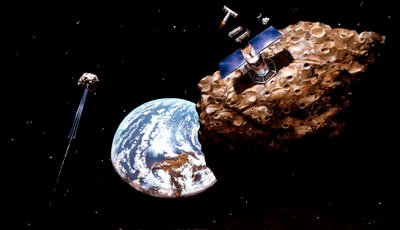Mining Asteroids
The consumption of resources on Earth is increasing rapidly, and we soon will need new sources.
Asteroids are often brimming with metals that take huge mining operations to get at down here on Earth. This means that capturing and mining asteroids may be a good alternative to many of the mining operations we have today.
The Value of an Asteroid
Asteroids come in three common types: C-type, S-type, and M-type.
C-type
C-type asteroids are the most common type (around 75%). They are carbonaceous and are mostly made up of clay and silicate rocks. They are often found farther away from the sun and are 22% water on average.
S-type
S-type asteroids are less common and account for 17% of all asteroids. They are siliceous and made up mostly of stone. S-type asteroids have high amounts of iron, nickle, and magnesium. These asteroids are most commonly found withing the inner asteroid belt.
M-Type
Metallic type asteroids are by far the least common. These asteroids generally occupy the middle of the asteroid belt. Metallic asteroids have a high levels of iron and other metals than the other types of asteroids. The other types of metals are mostly platinum group metals. The platinum group metals include: Platinum, Osmium, Iridium, Ruthenium, Rhodium, and Palladium. A single 500 meter wide M-type asteroids would have 1.5 times the worlds reserve of platinum metal groups. An asteroid just one kilometer in diameter could have over 160 billion dollars worth of platinum in it.
[1][2][3]
The Mining Process
The biggest problem with mining asteroids is that they are in space. Mining them here on Earth would require us to move them all the way here and expend massive amounts of fuel to stop the asteroids from burning up the Earths atmosphere. The way around this is moving them into orbit around Earth. This would allow small spacecraft armed with 3d printers to extract the metal and create the products we need out in space, and send them back down fully processed.
We already have companies that are planning on mining asteroids. Deep Space Industries, is one such company. Deep Space Industries is splitting the mining into three steps. First they are sending small "Firefly" cubesats on a one way trip to any asteroid that looks promising. The cubesat will analyse the asteroid and report back the findings. Next "Dragonfly" cubesats would be sent to promising ones to collect and return samples. Later they would develop a "Harvestor tug". The job of the Harvestor tug is to bring the best asteroids into Earths orbit where it can be mined without much difficulty. [4]
According to estimate it would cost about 2.6 billion dollars to bring back an asteroid 30 meters in diameter into Earth's orbit.
An asteroid this large would be worth 25-50 billion dollars. This is a massive return on investment and could supply much needed resources. [5]
Earth only has a limited supply of resources. We can not sustain our currant growth with the tools we have now and we must find new sources of resources in the future, and asteroid mining is one of the most promising.


Although the costs to mine astroids is really big, I was reading somewhere to develop mining further in eg Australia has equal or even more costs associated with it. Hence mining astroids becomes really attractive!
Always have been interested in the possibilities of this.. But what about radiation? The object sits there for a billion years and doesn't have any protection, does it effect the gold?
"Here love, I got you a space necklace, careful it is radioactive. In a year you may or may not have cancer..."
The sun radiates more photons than anything else, and all those can do is knock a few electrons off without much permanent effect
If you dont mind I want to share with my old post, cuz its very important and good topic https://steemit.com/technology/@natord/asteroid-mining-the-near-future-or-false-hope
Your post definitely goes into more detail lol. I don't mind you sharing your post ;)
Thank you :)
Great post- thanks for the stats- I had no idea that some asteroids were so dense in these metals. Perhaps build a space elevator and use the asteroid as the space counter weight? But then of course your couldn't mine it all away- or perhaps before fully mined you attach it to a newly docked asteroid- wash, rinse, and repeat?
We might use the extra bits as counter weight if it is needed, but I wouldn't trust asteroids that close to Earth tbh
Thanks for the excellent additional information I hadn't seen any details on, but have been curious about. I believe development of space should begin with drones and robotics. A big part of what slows us down in developing space is our concern and focus on putting people into space. We can speed this up by taking people out of the equation during the initial development and production. We could build the infrastructure to make it EASIER to get people into space. I wrote about this a bit more a couple of days ago, but I didn't have these interesting details you added which are very complimentary to my brainstorming ideas. :) Resteem.
Asteroid mining is probably even more important for non-earth settlements. Not least because of water.
yeah that's true
Nice post man! It's a real issue.
I've written about this before. There are trillions of dollars up there. I'm a stickler for the name for going from asteroid to asteroid; rock hopping.
Excellent post!! thank you for sharing
Thank you for this awesome post.